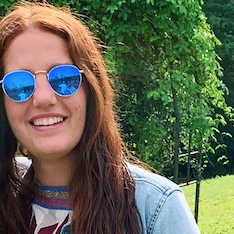
On June 13, 2017, fifteen-year-old me arrived at Camp about to begin my Gesher summer, the summer I had been waiting for my whole life. I stepped off the bus to be greeted by friends and counselors. Not even a minute after stepping foot on Camp grounds, I began to cry. Geoff Menkowitz approached me laughing and said, “You’re already crying?! You just got here! Sad you’re getting your last first day of Camp lice check?” I looked around and replied, “I’m crying because I am happy.” I was known as a crier at Camp and someone who cried tears of joy at the end of Kabbalat Shabbat, during seudat shlishit sloach, when my friends and I stayed up late on the porch and when the rope burned during Yom Sport. When each one of us enters 70 Darom Lane, we decide to be a part of a community that creates joy. Building joy as a collective is one of the most important things I’ve learned from Camp.
We are now in the month of Adar. The Talmud says, “When Adar enters, we increase joy” (B. Ta’anit 29a.) This is a time when as a Jewish people we decide to increase joy. We have to intentionally create moments to celebrate. So, we may be asking ourselves: How do we find joy? How can we be told to be happy? How do we increase joy as a community?
“When Adar enters, we increase joy”
The story of Purim, like many of our stories throughout Jewish history, is one of survival. Haman threatened the Jewish people’s existence. It is a story of great fear and great bravery. It is one in which Mordechai and Esther took it upon themselves to fight for the Jewish people. For these reasons, during the month of Adar and on Purim, we create moments of joy in song and dance, in costumes, in giving to those less fortunate, in baking hamentashen and in crafting homemade groggers. We find reasons to celebrate.
This story though also highlights the tension between the Jewish people and God. There were no big miracles, no splitting of the sea, just human actions that led us to survival. So, where was God?
This year, more than any other, we may be asking ourselves this same question. It has been a year of social distancing, loss, loneliness, and hardships for many of us. The joys of Purim, the singing, the dancing, the carnivals, mishloach manot and hamentashen can be done at a distance or on Zoom. We may have to be together virtually, and we may be running low on energy to create joy.
During this month of Adar, which occurs at such a strange point in the year, it is important to reflect on everyday things that can increase our joy. I find joy in spending time with friends, talking to my camp friends, good food, music, and many other “little” things. What I find most joy is seeing the sunset every day.
One of my rabbis at school once spoke about how each sunrise and sunset is a miracle we take for granted. When watching a sunset, I am reminded of the miracles of God and the beauty and joy of the world. To me, joy is a mindset.
Just like Esther was able to change her mindset and persevere through everything that came her way, we can too. We can find the little things that bring us joy and lighten and better our lives. I challenge you to find the things that bring you joy during this time and truly allow them to better your life in some way.
Purim Sameach and Shabbat Shalom!
Mili Cattan, Ramah Service Corps Fellow
